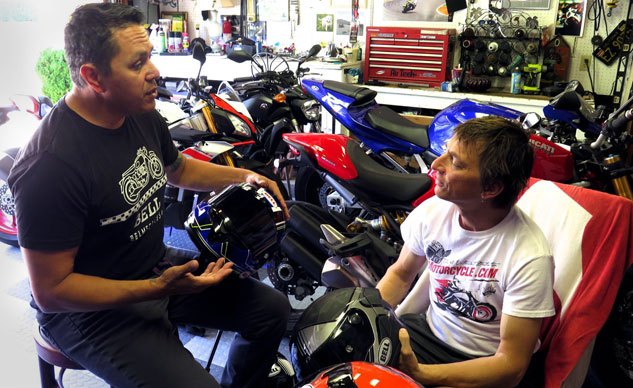Bell Helmets Shows Us Race Star and Pro Star Lids
Guess who wants to re-own the high-end helmet market?
At one time back there in the mists of time, a Bell helmet was the motorcycle helmet to have. If Bell didn’t invent the full-face helmet, they did have the first one everybody wanted. Things changed, the brand was sold, quality became poor or inconsistent, and those of us lucky enough to have our druthers started wearing Shoeis, Arais and other expensive foreign lids.
Ahh, it seems like that’s about to change or maybe already has. I got my head into a new Star a couple months ago, and found a lot to like – especially the fit, which is the most important thing in any helmet. But that base-model Star is one of three; its sibling lids the Pro Star and Race Star will hit the market soon, and Bell reps Zach Kadletz and Rob Salcedo (on the left in the photo above with EiC Duke) were good enough to drop by and fill us in on some of those helmets details.
Mainly, Bell is out to once again establish itself as the high-end helmet manufacturer; the Pro Star starts at $1199.95, the Race Star at $699.95. The difference between those two is that the Pro Star’s shell is made of TeXtreme carbon-fiber, a lighter, cutting-edge c-f weave that makes the Pro 120 grams lighter than the Race Star’s conventional carbon shell. High school (parking lot) math tells us that’s 4.3 ounces or a bit more than a quarter-pound, which is a significant weight/aerodynamic savings especially if you’re Josh Herrin or Cameron Beaubier, Bell-sponsored racers.
The Flex liner also provides a really good fit, what Bell calls an “adaptive fit.” The shell itself is a really good shape as I discovered in my earlier review, and the fact that it’s produced in five sizes means everybody gets the best possible fit. In fact, Bell claims the Flex three-layer liner takes the new Stars partway toward the fit provided by its Custom Fit program, where it scans the buyer’s head using a 3D scanner. (Bell is also working on a trick new way to expand Custom Fit via a much simplified scanning system.)
Furthermore, those three layers of liner provide a bit of MIPS effect, as in the helmet is able to rotate on the skull a bit when there’s an impact. Most motorcycle crashes, we’re told, involve a skidding hit as opposed to just a flat one, and the ability of the helmet to rotate a small amount helps absorb that energy and better protect the coconut. Bell, which claims it has the biggest helmet testing lab in North America, says the Flex liner performs extremely well against conventional helmets.
But wait, that’s not all!! The channels within and between the lining layers are said to provide improved ventilation (and I learned about the removable plug in the chin bar of my Star, which lets it breathe much better now).
Then you’ve got your Panovision eyeport, which is a bit wider for better peripheral vision (maybe Marquez would be better able to not ram people if he had it?), and the Stars all boast Class-1 optics in their thicker-than-average faceshields. A Transitions photo-reactive shield will cost an extra $129. The base Star and the other two share the same shield, but the eyeport in the Race and Pro Stars are angled slightly more upward for improved peripheral race-track visibility.
In short, if you were thinking about treating a loved one (or yourself) to a new high-end helmet, you might want to hold off another month until the Pro Star and Race Star are available. These are sweet lids, and more are on the way says Rob Salcedo. Stay tuned for official MO test results.
For more information, visit BellHelmets.com.
More by John Burns




































Comments
Join the conversation
Everything is so damned expensive. My 1st Motorcycle cost half of the amount for a Helmet.
Almost one year ago, i was looking for a new lid. I try to support local brick-and-mortar stores, so I headed to my nearest dealer and found the usual suspects, HJC, Shoei, Scorpion, etc. The salesman pointed me to a Bell helmet for about $800. I guess my face gave away my skepticism.
"Bell is making the best helmets again."
"Oh, really? Just because they make a completely unsupported claim doesn't mean it's true. For that much money, I'll have an Arai. Thank you very much."
I guess this new information on their three-part helmet liner is helpful. But it's still really just unsupported claims.
"Bell, which claims it has the biggest helmet testing lab in North America, says the Flex liner performs extremely well against conventional helmets."
Okay, I'm interested, but how about some numbers? What sort of testing do they do? What are the measurable outcomes? Are they consistent and repeatable? How do other helmets perform in the same tests?
I don't think Arai and Shoei publish a whole lot of testing figures, either. But they are the established standard for premium helmets. If Bell wants me to pay that kind of money, they'll have to do more than hype the market.